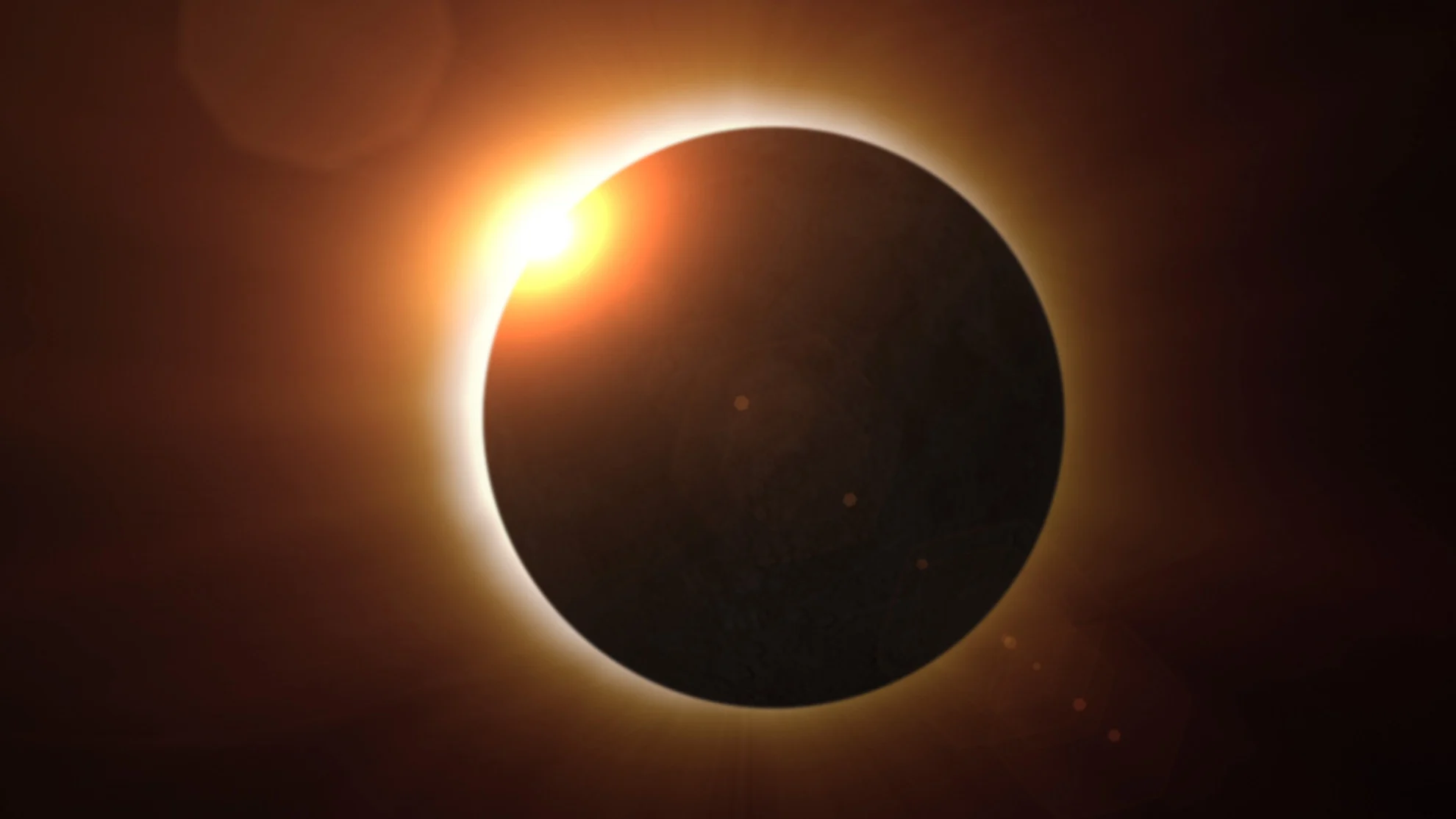
Are you ready for the April 8th Total Solar Eclipse? Here's how to prepare
It's nearly eclipse day! Are you ready?
Here's what you need to know to get the most out of this year's most anticipated celestial event.
During the day on Monday, April 8, 2024, the Sun, Moon, and Earth are going to line up perfectly to produce a total solar eclipse. At that time, the shadow of the Moon will sweep across the face of the Earth, tracing a path from southwest to northeast across North America.
All of Canada has a chance to see at least a partial eclipse during this event. That has been the case for over a half-dozen solar eclipses during the past few decades. However, this time we are in for a special treat.
For millions of Canadians, this will be the first time since February 26, 1979 that they'll see a total solar eclipse without having to stray far from home.
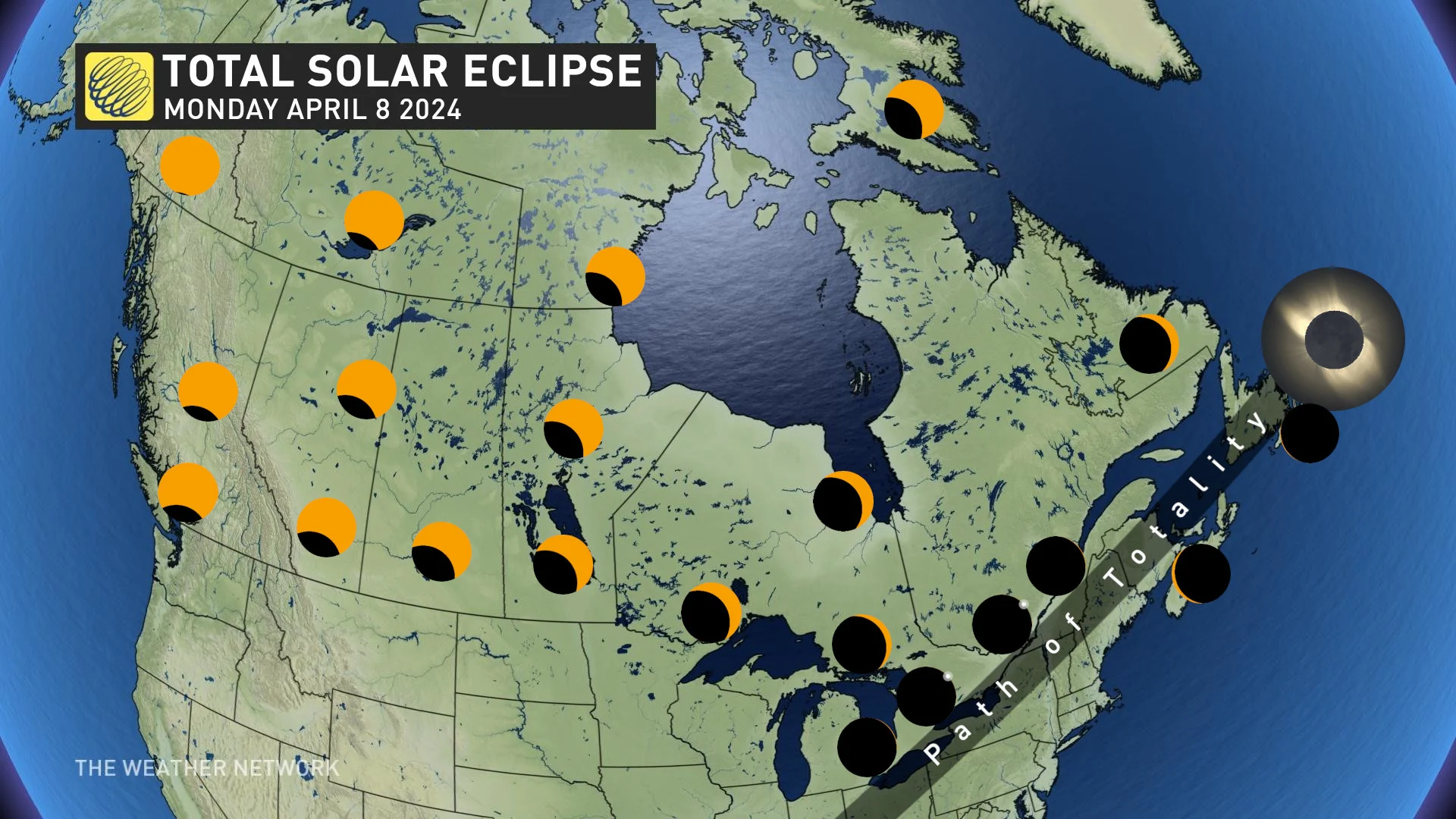
The view of the October 14 annular eclipse from Canada was better from farther west, with observers along the south coast of B.C. and Vancouver Island getting the best show.
However, on April 8th, it will be roughly the opposite.
Only a thin sliver of the Sun will be blocked by the Moon for those watching from the west coast. The farther east you are, the more aligned the Sun and Moon will be in the sky. And with that greater alignment, more of the Sun's disk will be covered by the Moon.

Timing and duration
Due to our use of time zones, the rotation of the Earth, and the passage of the Moon's shadow across the planet's surface, the eclipse occurs at different times for different observers.
This eclipse will first become visible in Canada at 10:40 a.m. PDT, in southwestern British Columbia and will begin later, the farther north and east an observer is. For example, accounting for both the change in time zones and the time it takes for the movement of the Moon's shadow across Earth's surface, the eclipse begins at 2:04 p.m. EDT in Toronto, Ontario and 4:09 p.m. NDT in St. John's Newfoundland.
Duration and maximum eclipse also depend on the observer's location. In the north, eclipse maximum in Whitehorse occurs at 11:35 a.m. MST, only 18 minutes after it began, with only 4 per cent of the Sun covered by the Moon. The eclipse will end just 19 minutes later, at 11:54 a.m. MST.
In Sudbury, Toronto, and Hamilton, the eclipse reaches maximum at 3:19 p.m. EDT, and in Niagara Falls only one minute later. Each city has a very different look at maximum eclipse, though. The 'magnitude' in Sudbury will be 90 per cent, in Toronto over 99.99 per cent, and Hamilton and Niagara will experience totality — for 1 minute and 50 seconds in Hamilton, and 3 minutes and 31 seconds in Niagara Falls.
DON'T MISS: Everything you need to know for April's spectacular and rare solar eclipse
The Path of Totality
The absolute best views of the April 8, 2024, solar eclipse are expected along a roughly 200-kilometre-wide line stretching from the equatorial Pacific to the north Atlantic, crossing through Mexico, the United States, and eastern Canada.
This is the Path of Totality, and it is where the Moon will appear to completely cover the Sun. Observers in that path will witness an eerie darkness cast over over the area as the Moon's shadow sweeps past. They will also have a chance to see the Sun's corona for themselves.
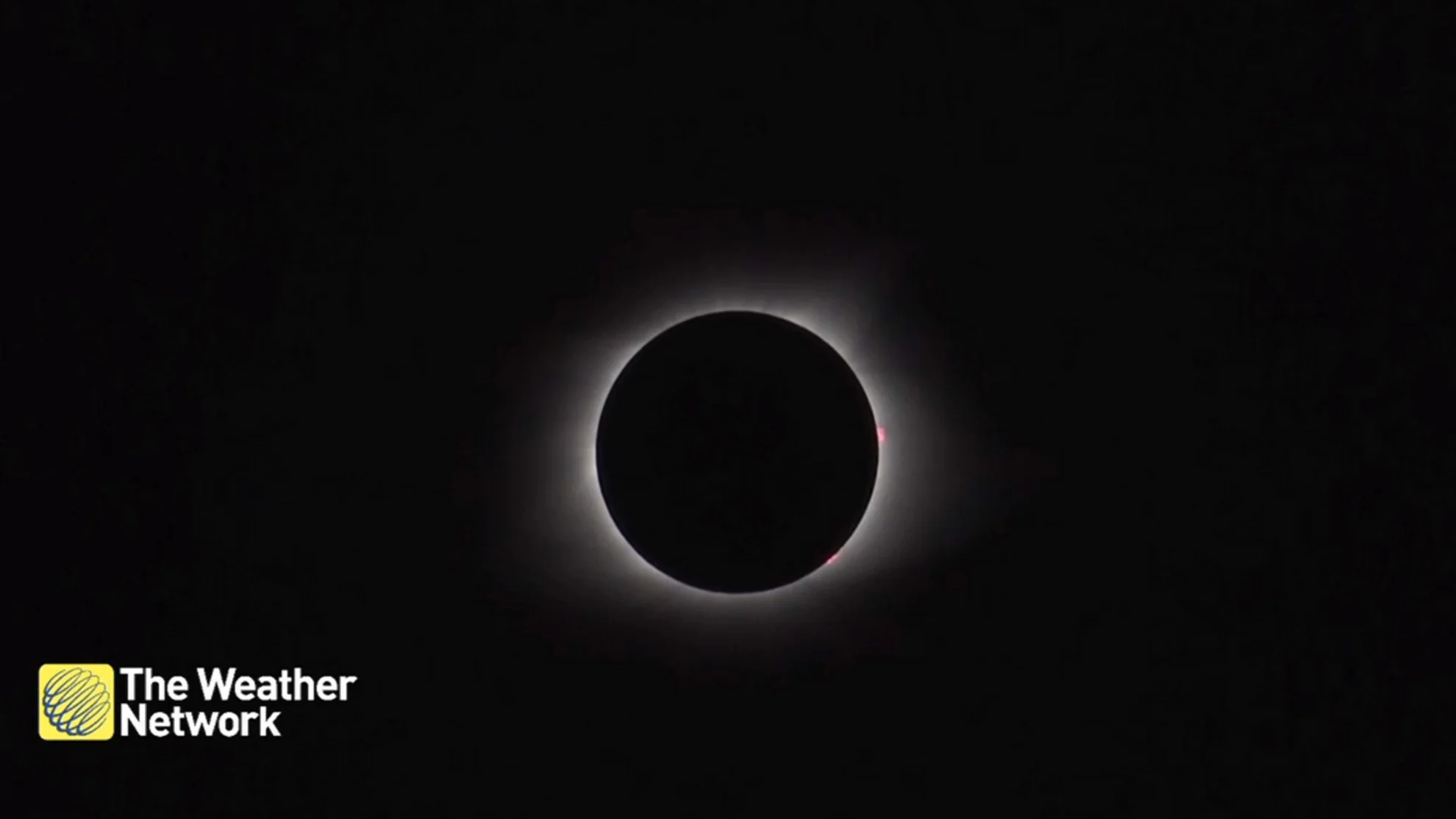
This view of the August 17, 2017 total solar eclipse was captured from Silver Point, Tennessee, during The Weather Network's livestream of the event. Credit: The Weather Network
In Canada, the northern edge of the path of totality enters the country just east of Levergood Beach, along the shores of Lake Erie to the south of Windsor, Ont. From there, the path traces a relatively straight line to the east-northeast, with the northern edge passing south of London, north of Hamilton, and through Burlington.
In this region, the eclipse begins around 2 p.m., reaches maximum around 3:15 to 3:20 p.m., and it ends just before 4:30 p.m. EDT. The best place to be is along the north shore of Lake Erie, in Hamilton, or anywhere along the Niagara Peninsula. However, the longest totality for all of Canada will be seen in Fort Erie, where the Moon will block the Sun for a total of 3 minutes and 46 seconds.
The path of totality just misses the most populous regions of the Greater Toronto Area. From there, observers will see as close to a total eclipse as you can get without it actually reaching 100 per cent. In the GTA, the eclipse begins just after 2 p.m., reaches maximum at around 3:19 p.m., and ends at 4:31 p.m. EDT. At maximum, the Moon will cover over 99.9 per cent of the Sun, giving the region a prolonged view of a phenomenon known as Baily's Beads (read on for more details).
The path of totality (shaded area) through southwestern Ontario and the Niagara Peninsula. The orange line denotes where the edge of the Moon's shadow will reach as it sweeps through. Credit: NASA/Google Maps/Scott Sutherland
After passing over Lake Ontario, the Moon's shadow comes back on shore in Canada just east of Port Granby and follows the St. Lawrence River.
Here, the eclipse begins just after 2 p.m., reaches maximum between 3:20-3:27 p.m., and it ends after 4:30 p.m. EDT.
While Ottawa experiences an eclipse magnitude of 98 per cent, many communities throughout eastern Ontario will have the same opportunity as the GTA to witness Baily's Beads. Meanwhile, those viewing from along the shores of Lake Ontario and the St. Lawrence will experience totality starting between 3:20 p.m. (Coboug) and 3:26 p.m. (Cornwall), and lasting anywhere between 2 and 3 minutes.
The path of totality (shaded area) through eastern Ontario. The orange line denotes where the edge of the Moon's shadow will reach as it sweeps through. Credit: NASA/Google Maps/Scott Sutherland
From there, the shadow passes over Laval and the southern half of Montreal, plus Montérégie, Estrie, the southern edge of Centre-du-Québec, and southern Chaudière-Appalaches region.
The exact centre-line of the path of totality, where the duration of totality will be greatest, goes straight through the Eastern Townships.
For southern Quebec, the eclipse begins between 2:14 and 2:18 p.m., reaches its peak around 3:30 p.m. and ends by 3:35 to 3:40 p.m. EDT. Those regions in the path of totality will see the Moon completely block the Sun for 1 minute and 27 seconds (southern Montreal) up to 3 minutes and 26 seconds (Sherbrooke).
The path of totality (shaded area) through southern Quebec. The orange lines denote where the edges of the Moon's shadow will reach as it sweeps through. The blue line is the centre-line of the shadow's path. Credit: NASA/Google Maps/Scott Sutherland
After that, the shadow crosses through central New Brunswick and the western half of Prince Edward Island.
Observers in this part of the country will see the eclipse begin around 3:20 p.m. ADT, reach maximum just after 4:30 p.m. and end around 5:40. Only the northern and southern parts of New Brunswick and the southeastern half of P.E.I will not see totality. The rest of this region will witness this event for between 1 minute and 2 seconds (Summerside, PEI), to 1 minutes and 22 seconds (Grand Falls, NB), to 2 minutes and 17 seconds (Fredericton, NB), up to 3 minutes and 8 seconds (Miramichi, NB).
The path of totality (shaded area) through central New Brunswick. The orange lines denote where the edges of the Moon's shadow will reach as it sweeps through. The blue line is the centre-line of the shadow's path. Credit: NASA/Google Maps/Scott Sutherland
Across the Gulf of St. Lawrence, the path of totality passes directly over the Magdalen Islands. Here, the eclipse begins at 3:29 p.m., peaks at 4:39 p.m., and ends at 5:44 p.m. ADT. Totality will last for a maximum of 3 minutes and 9 seconds.
The southern edge of the path also crosses the northern tip of Cape Breton Island. There, the eclipse starts at 3:31 p.m., peaks at 4:40 p.m. (for a total of 1 minute and 9 seconds), and ends at 5:45 p.m. ADT.
The path of totality (shaded area) over the Gulf of St. Lawrence. The orange lines denote where the edges of the Moon's shadow will reach as it sweeps through. The blue line is the centre-line of the shadow's path. Credit: NASA/Google Maps/Scott Sutherland
Lastly, the shadow will travel through the middle of the island of Newfoundland.
Port Aux Basque will see the eclipse start at just after 4 p.m., peak at 5:11 p.m. (for 2 minutes and 47 seconds), and end at 6:15 p.m. NDT. In Gander, the eclipse is from 4:07-6:16 p.m. NDT, and it peaks for 2 minutes and 13 seconds, starting at just before 5:13 p.m. NDT.
Bonavista and the surrounding communities will be the last place in Canada to see the total eclipse. There, the eclipse begins at 4:08 p.m., reaches max from exactly 5:13:45 to 5:16:39 p.m., and ends at 6:17 p.m. NDT.
The path of totality (shaded area) across Newfoundland. The orange lines denote where the edges of the Moon's shadow will reach as it sweeps through. The blue line is the centre-line of the shadow's path. Credit: NASA/Google Maps/Scott Sutherland
READ MORE: How to safely watch the April 8 total solar eclipse
The best place to watch from?
Observing a solar eclipse from anywhere can be a very special event. Additionally, any location along the path of totality with clear skies on April 8, 2024 will no doubt have an excellent view of the total solar eclipse.
However, if you want to see totality with your own eyes, there are a few things to consider when choosing your viewing spot.
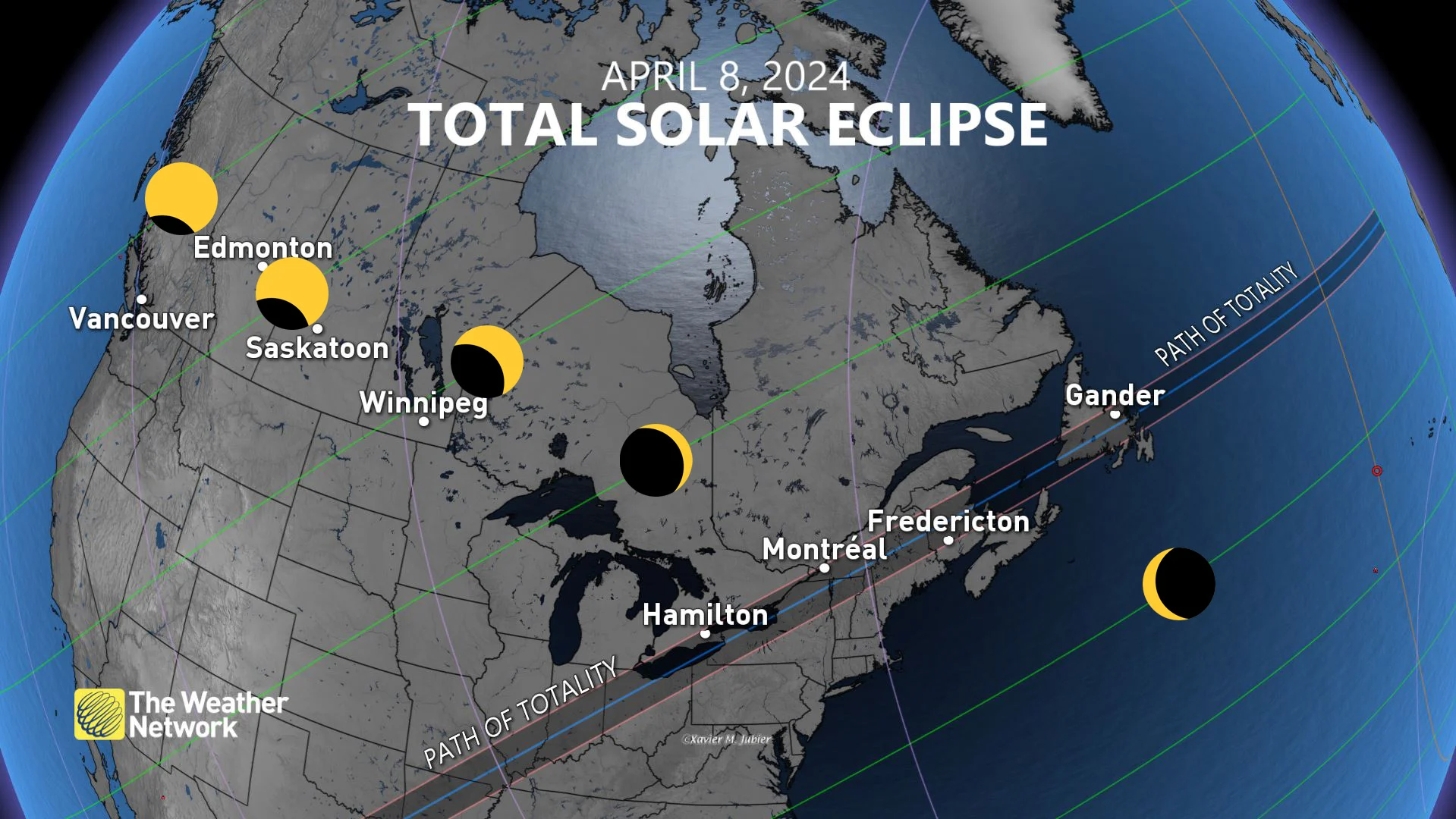
Depending on exactly where you are along the path of totality and how close you are to its centre-line, the duration of totality changes.
The absolute longest totality observed during this event will be around 4 minutes and 30 seconds, from the point of Greatest Eclipse located in the middle of northern Mexico. The farther you are from that point along the path of totality, the shorter the total eclipse will be. Also, for any point along the path of totality, the duration gets shorter the farther off the centre-line you are.
So, the longest duration total eclipse seen from Canada for this event will be in the location that is farthest to the southwest along the path of totality, as well as closest to the centre of the path.
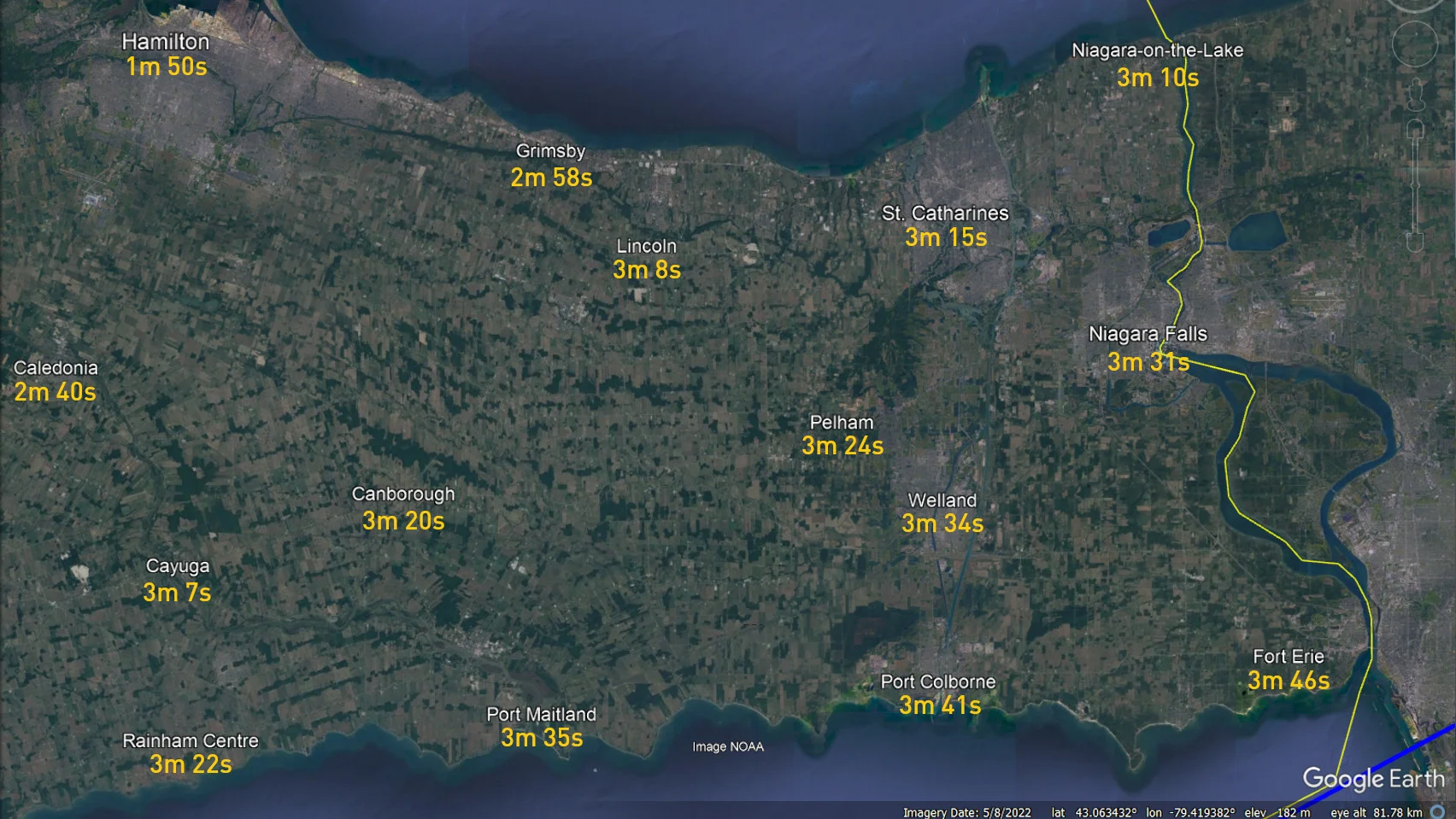
This map of the Niagara Peninsula shows the duration of totality for various locations throughout the region. Credit: NASA/Google Earth/Scott Sutherland, totality durations courtesy timeanddate.com
That distinction goes to Fort Erie, Ont., where observers will see the Moon completely cover the Sun for 3 minutes and 46 seconds! Other locations along the northeastern shores of Lake Erie and southeastern Niagara Peninsula will see at least 3 minutes and 30 seconds of totality.
Among the Eastern Townships of southern Quebec is another excellent place to watch the eclipse.
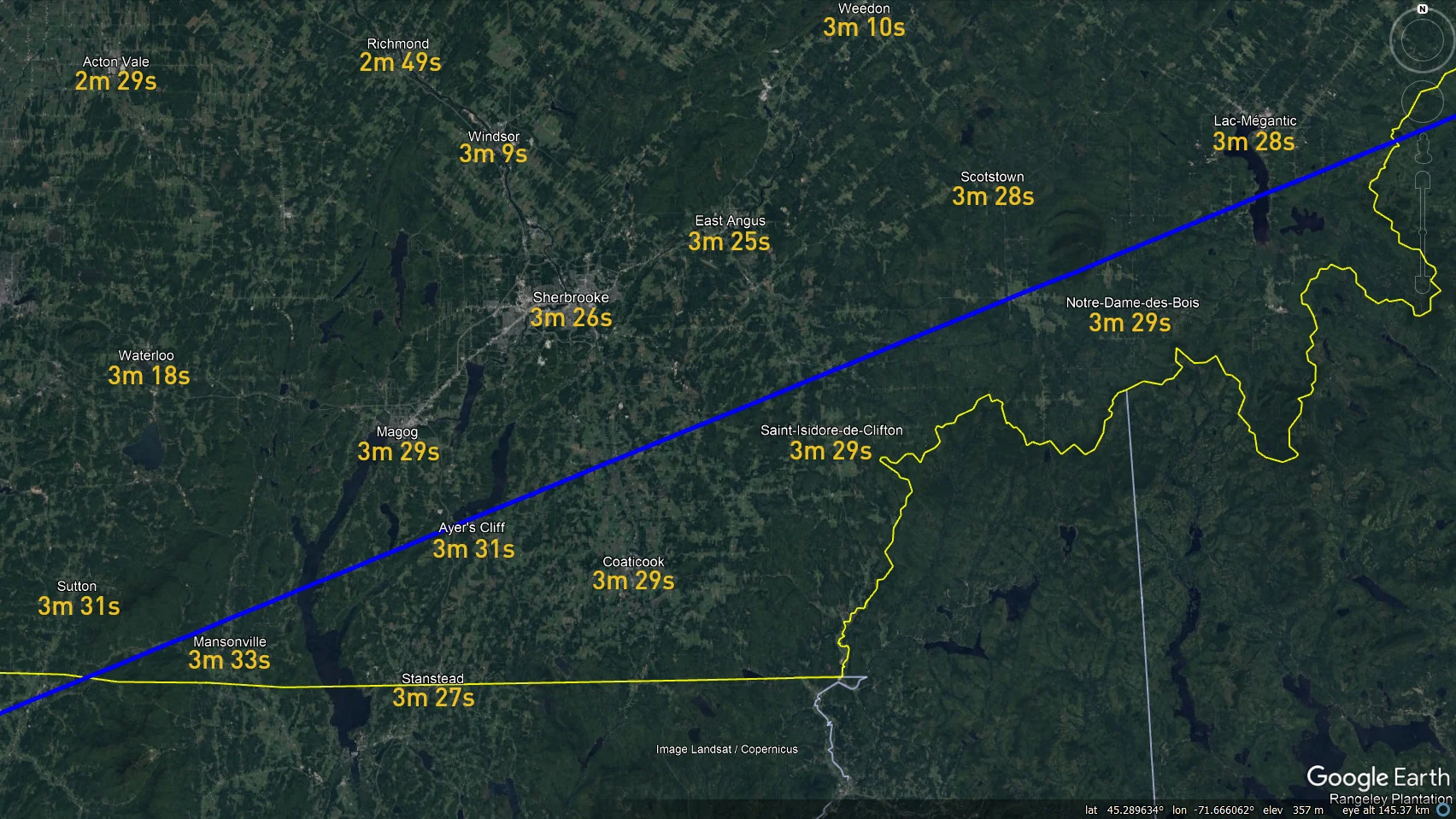
This map of the Eastern Townships shows the duration of totality for various locations throughout the region. Credit: NASA/Google Earth/Scott Sutherland, totality durations courtesy timeanddate.com
Although it's farther northeast, reducing the overall duration of totality, this is the first location in Canada that you can stand directly on the center-line of the shadow's path. From there, observers will see up to 3 minutes and 32 seconds of totality.
This diminishes to around 3 minutes and 20 seconds along the centre-line through New Brunswick, and to around 3 minutes through Newfoundland.
Who will have clear skies?
Having reasonably clear skies is essential for viewing a solar eclipse.
It's impossible to accurately forecast the exact sky conditions for one particular afternoon, three months into the future. However, looking at the past can offer some insights into who is most likely to have clear skies for this total solar eclipse.
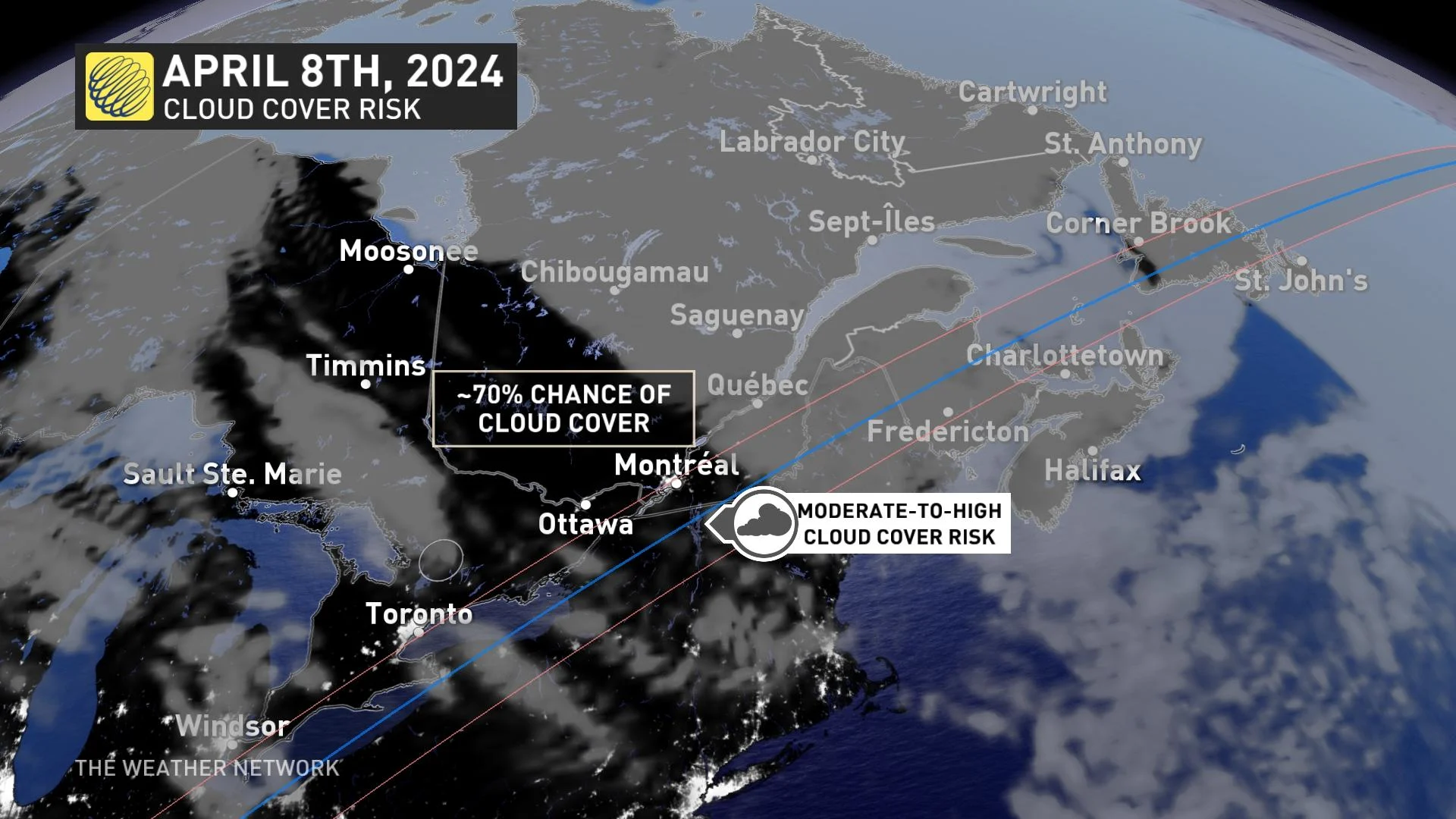
The map above is based on a forecast posted by climatologist Brian Brettschneider just one day after the August 21, 2017, solar eclipse.
It is not intended to be an accurate weather forecast map. It simply shows what sky conditions have typically been like in early April, based on historical data.
Across southern Ontario and Quebec, Nova Scotia, and Prince Edward Island, there's usually around 60 to 70 per cent cloud cover. For New Brunswick, P.E.I., and Newfoundland, it's more like 70 to 80 per cent cloud.
That's not great news for Canadians who want to see the eclipse. However, we will have much more accurate forecasts leading up to the event.
Toronto and Montreal
Toronto and Montreal get a special mention here, because millions of potential eclipse watchers located in those two urban areas may catch a glimpse of a very cool eclipse phenomenon known as Baily's Beads.
This closeup of the GTA and Montreal shows their locations in relation to the total solar eclipse path of totality. Credit: NASA/Google Maps/Scott Sutherland
The Greater Toronto Area won't see true totality during this eclipse. From Oakville to Oshawa, this major metropolitan area is too far north to see the Moon completely block the Sun. The same goes for the northeastern half of Montreal.
However, from both of those locations, and really from anywhere located just outside of the path of totality, the Moon will cover more than 99.9 per cent of the Sun. That gives everyone watching from there the chance to catch a sight like this:
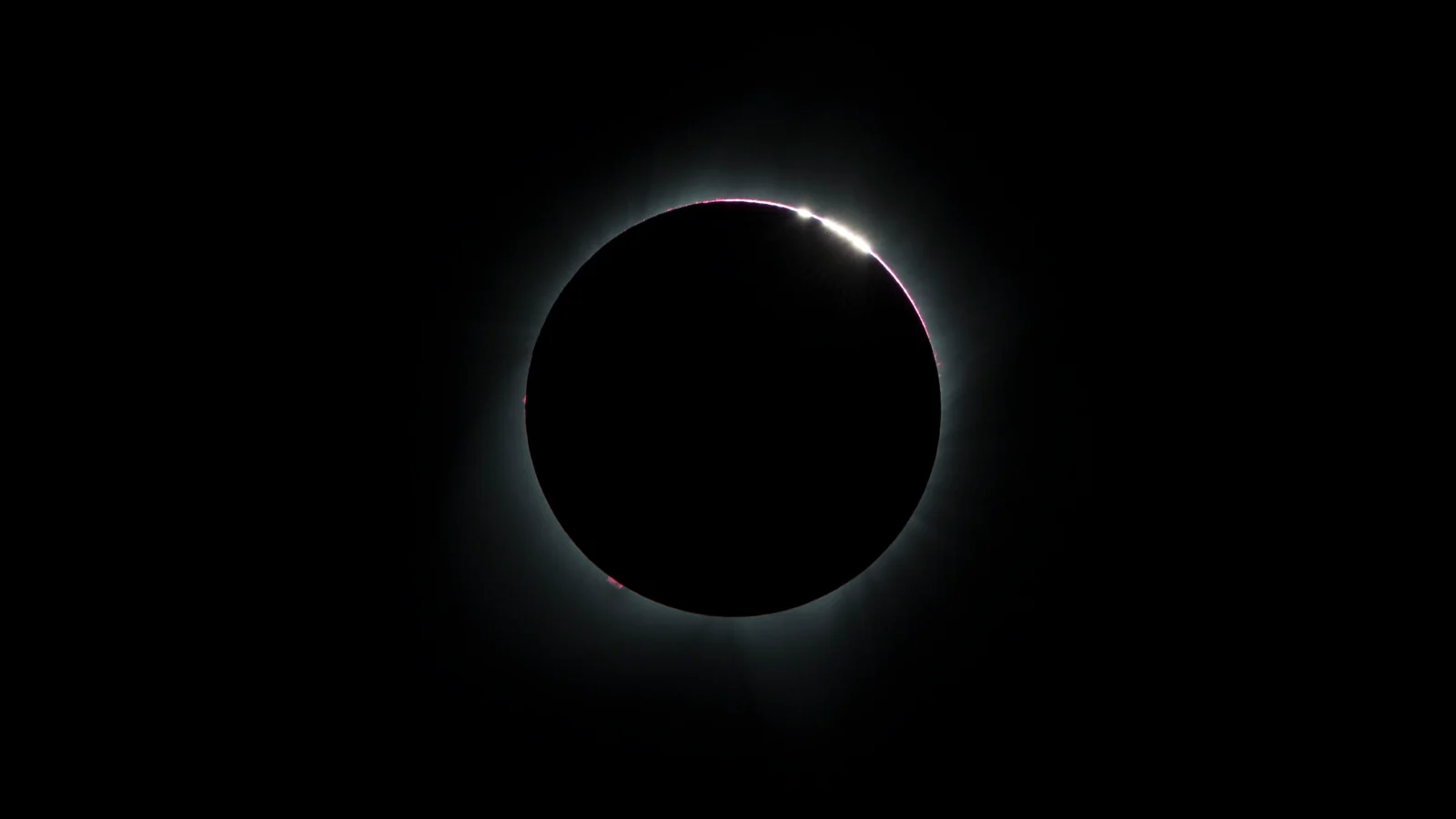
An image of Baily's Beads captured during the August 21, 2017 Total Solar Eclipse. The picture is shown upside down here, to represent where the GTA and Montreal may see them for the April 8, 2024 solar eclipse. Credit: NASA/Aubrey Gemignani
Baily's Beads are bright spots of light seen just along the edge of the Moon's disk during a total solar eclipse. These occur for a moment or two, just before the Moon completely covers the Sun, when the edge of the Moon is lined up almost perfectly with the edge of the Sun.
At that time, nearly all of the Sun's light is blocked by the Moon, except a few rays of sunlight that slip through gaps between the mountains and other rough terrain along the limb of the Moon.
Anyone in the path of totality has a chance to see these phenomena for a brief second or two before they vanish. However, those observing from just outside of the path of totality could have a few minutes when Baily's Beads are visible!
Protect your eyes!
Watching the upcoming eclipse as it is livestreamed on your smartphone, computer or television screen is perfectly safe. However, if you're outside watching it for yourself, no matter where you are viewing it from, you will need some kind of eye protection.
The most common type you'll find is eclipse glasses. Some high-end versions are plastic and look similar to ordinary sunglasses. However, most eclipse glasses are made of printed cardstock and have thin mylar 'lenses'. Even though the 'lenses' on these glasses are so thin, they still block out over 99.99 per cent of all light from the Sun.
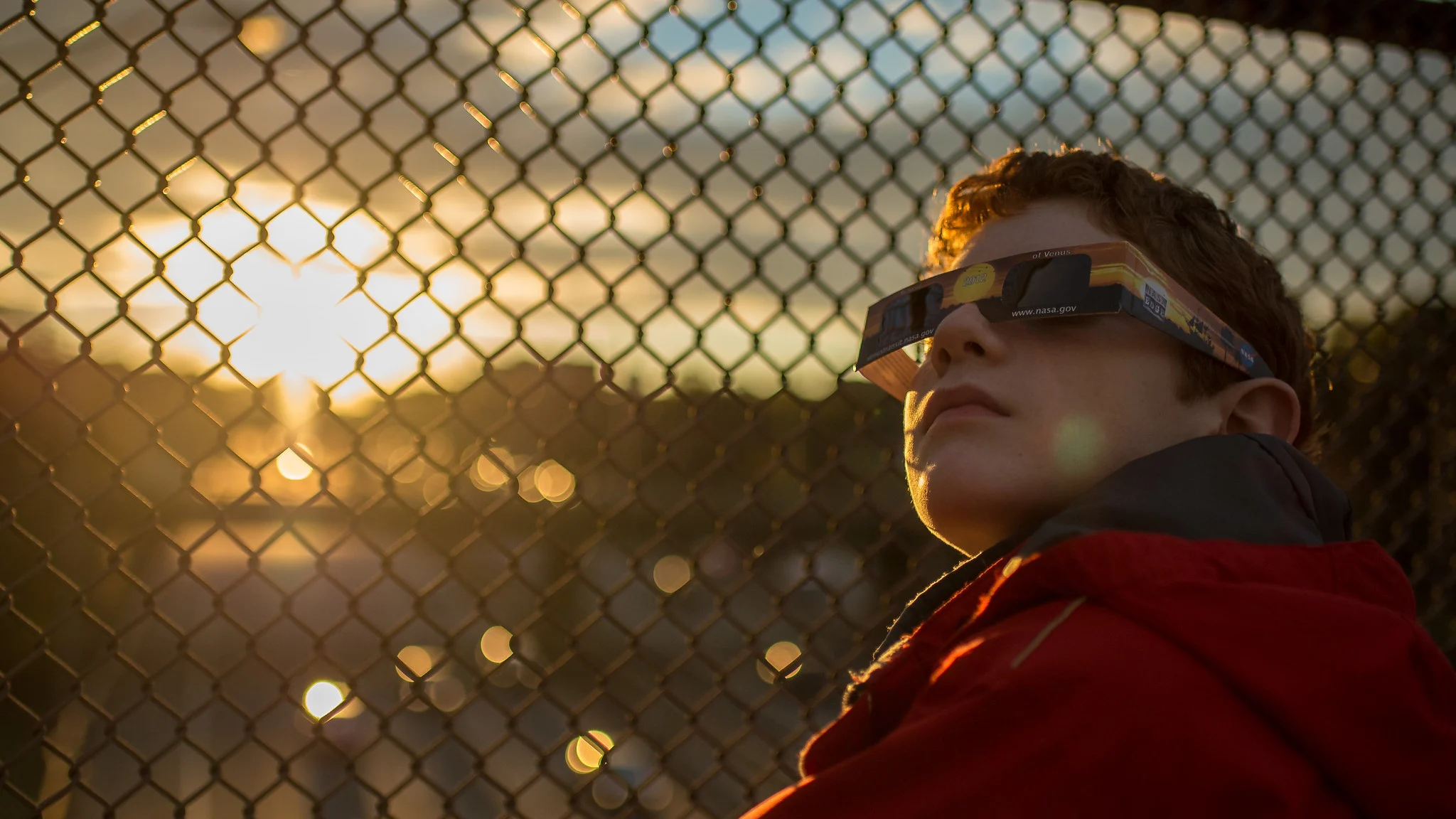
Credit: NASA/Bill Ingalls
To ensure that your eclipse glasses are genuine and meet the standards required for safe solar viewing get your eclipse glasses from a reputable vendor, such as the Royal Astronomical Society of Canada.
Alternatively, you can find your local branch of RASC, who will no doubt be hosting a eclipse viewing party on the day of the event, and should have a good supply of eclipse glasses on hand for those that attend.
For those who wish to use a camera, telescope, or binoculars during the event, don't forget to buy a proper solar filter that fits your equipment. Some astronomical companies also make specially-designed solar-viewing binoculars.
Note, however, that none of these devices are required to enjoy an eclipse. Also, under no circumstances should you point an unfiltered camera, telescope, or binoculars at the Sun during any part of the eclipse, except exactly at totality. The smallest amount of unfiltered sunlight could potentially damage the optics of these devices. Even worse, focused sunlight passing through these devices into your eyes can result in permanent blindness.
For everyone watching the eclipse from outside the path of totality, eye protection should be used at all times during the event. Even those viewing from the edge of the path of totality, when less than 0.01 per cent of the Sun is visible, that is still enough sunlight to potentially damage your eyes if you look for longer than a second.
The same rule applies to those observing from within the path of totality. Eclipse glasses should be worn right up until the time when the Moon completely blocks the Sun, and then again from just before the Sun re-emerges from behind the Moon.
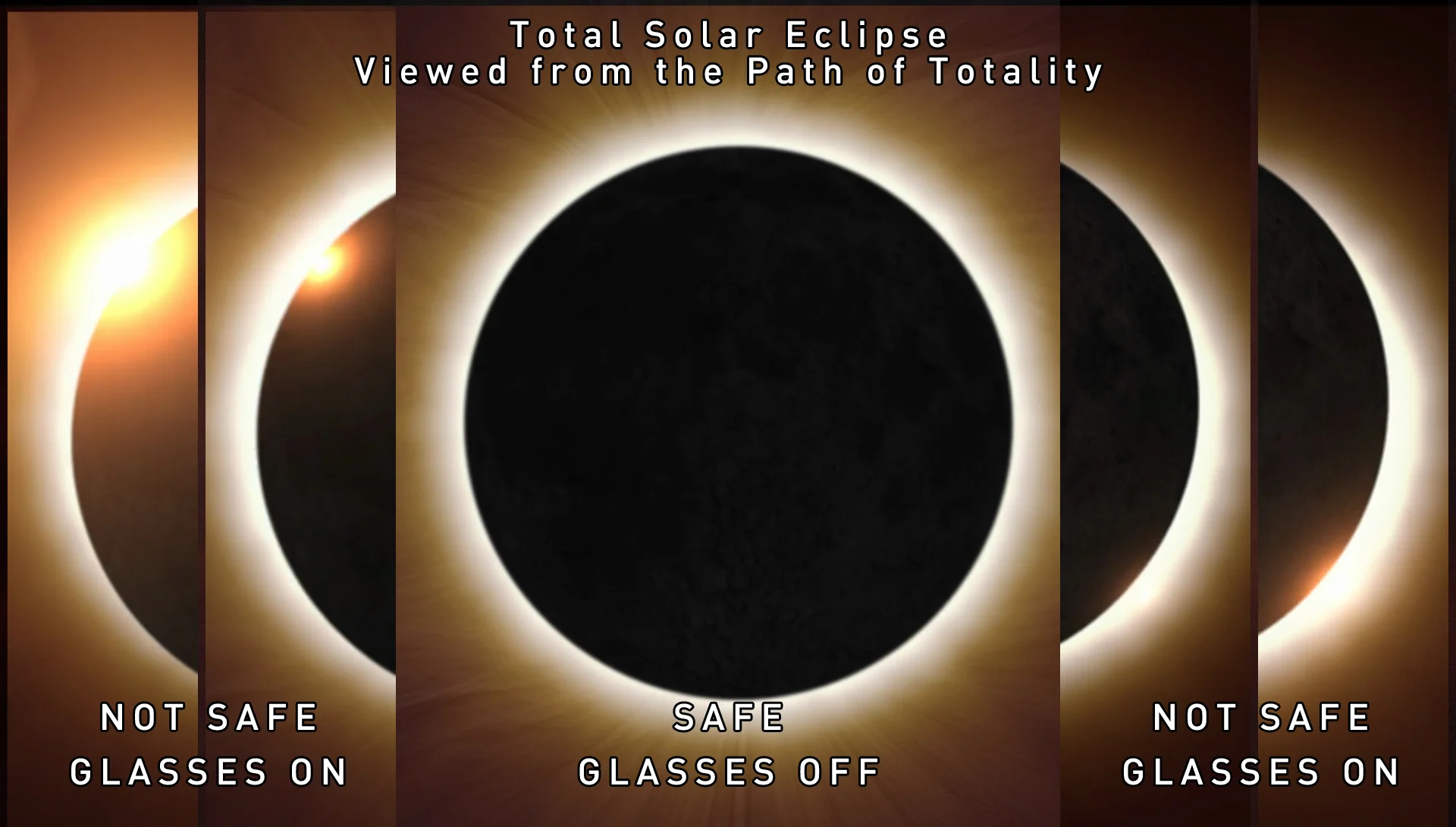
However, there is a brief period, right when the Moon is completely covering the Sun, when it is safe to remove your glasses. In fact, it's actually best to remove them at that time! You won't see anything at all with them still on, and will miss your chance to see the solar corona glowing around the Moon's disk.
Just be mindful of exactly how long totality lasts, so that you can put your glasses back on before the limb of the Sun emerges from behind the Moon.
Alternatively, if you can't get ahold of a pair of eclipse glasses, you can make an indirect way of viewing, such as a pinhole solar projector.
The NASA video below provides instructions for this, using a cereal box, paper, aluminum foil, scissors, a pin, and tape.
For a simpler method, grab a push pin and two pieces of white paper or cardstock. Poke a small hole in one of the pieces of paper with the pin. Stand facing directly away from the Sun and hold up that paper up next to your head, so you can see the paper's shadow on the ground in front of you. Line up the other piece of paper between the paper with the pinhole and the ground. A small dot of light will appear on the page. That is a pinhole projection of the Sun, and you can watch the Moon partially cover it throughout the event. Adjusting the distance between the two pieces of paper will bring the Sun into better focus. (Watch CaLisa Lee demonstrate this process in a Planetary Society video.)
The same effect can be produced by holding up an object with small holes in it, such as a straw hat, a pasta strainer, or a slotted spoon. The gaps between the leaves of a tree will also create this effect. Each hole or gap will produce its own projection of the Sun. Place a piece of paper on the ground to make these projections easier to see.
(Thumbnail image courtesy NASA)











